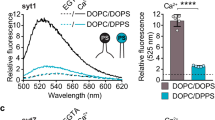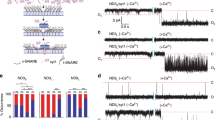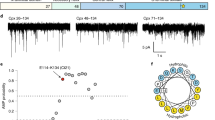Abstract
Exocytosis, or the fusion of cytoplasmic vesicles with the cell membrane, occurs in nearly all eukaryotic cells, but its mechanism is not understood. Morphological1,2 and electrophysiological studies3–5 have suggested that membrane fusion begins with the formation of a 'fusion pore', a narrow channel across the closely adjacent membranes of vesicle and cell that forms the first connection of the vesicle lumen with the cell exterior and later dilates to allow release of vesicle contents. We used the patch clamp technique to study exocytosis of single giant secretory vesicles in mast cells of beige mice4,5. The first opening of the fusion pore was found to generate a brief current transient, whose size and direction indicated an initial pore conductance of about 230 pS and a lumen-positive vesicle membrane potential. In time-resolved a.c. admittance measurements, the pore conductance was found to increase to much larger values within milliseconds, as if the pore dilated soon after opening. We conclude that the earliest fusion event may be the formation of a structure similar to an ion channel. Its conductance is of the same order of magnitude as that of a single gap junction channel, the only other known channel that spans two membranes.
This is a preview of subscription content, access via your institution
Access options
Subscribe to this journal
Receive 51 print issues and online access
$199.00 per year
only $3.90 per issue
Buy this article
- Purchase on Springer Link
- Instant access to full article PDF
Prices may be subject to local taxes which are calculated during checkout
Similar content being viewed by others
References
1. Chandler, D. E. & Heuser, J. E. J. cell Biol. 86, 666–674 (1980). 2. Ornberg, R. L. & Reese, T. S. J. cell Biol. 90, 40–54 (1981). 3. Fernandez, J. M., Neher, E. & Gomperts, B. D. Nature 312, 453–455 (1984). 4. Zimmerberg, J., Curran, M., Cohen, F. S. & Brodwick, M. Proc. natn. Acad. Sci. U.S.A. 84, 1585–1589 (1987). 5. Breckenridge, L. J. & Aimers, W. Proc. natn. Acad. Sci. U.S.A. 84, 1945–1949 (1987). 6. Lindau, M. & Fernandez, J. M. J. gen. Physiol. 88, 349–368 (1986). 7. Kendall, M. D. & Warley, A. J. cell Sci. 83, 77–87 (1986). 8. Johnson, R. G., Carty, S. E., Fingerhood, B. J. & Scarpa, A. FEBS Lett. 120, 75–79 (1980). 9. Salama, G., Johnson, R. G. & Scarpa, A. J. gen. Physiol. 75, 109–140 (1980). 10. Veenstra, R. D. & De Haan, R. L. Science 233, 972–974 (1986). 11. Unwin, P. N. T. & Zampighi, G. Nature 283, 545–549 (1980). 12. Hille, B. Ion Channels of Excitable Membranes, 186–188 (Sinauer Associates, Sunderland, Massachusetts, 1984). 13. Helander, H. F. & Bloom, G. D. J. Microscopy 100, 315–321 (1974). 14. Hamill, O. P., Marty, A., Neher, E., Sakmann, B. & Sigworth, F. J. Pflugers Arch. ges. Physiol. 391, 85–100 (1981). 15. Neher, E. & Marty, A. Proc. natn. Acad. Sci. U.S.A. 79, 6712–6716 (1982). 16. Falk, G. & Fatt, P. Proc. R. Soc. 160, 69–123 (1964).
Author information
Authors and Affiliations
Rights and permissions
About this article
Cite this article
Breckenridge, L., Almers, W. Currents through the fusion pore that forms during exocytosis of a secretory vesicle. Nature 328, 814–817 (1987). https://doi.org/10.1038/328814a0
Received:
Accepted:
Issue Date:
DOI: https://doi.org/10.1038/328814a0
This article is cited by
-
Membrane transformations of fusion and budding
Nature Communications (2024)
-
Resolving kinetic intermediates during the regulated assembly and disassembly of fusion pores
Nature Communications (2020)
-
The function of TRP channels in neutrophil granulocytes
Pflügers Archiv - European Journal of Physiology (2018)
-
Spatial distribution of conductivity in a short charged nanofluidic pore
Microfluidics and Nanofluidics (2017)
-
The blockade of the neurotransmitter release apparatus by botulinum neurotoxins
Cellular and Molecular Life Sciences (2014)
Comments
By submitting a comment you agree to abide by our Terms and Community Guidelines. If you find something abusive or that does not comply with our terms or guidelines please flag it as inappropriate.



